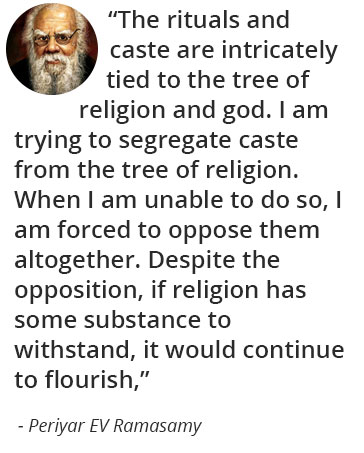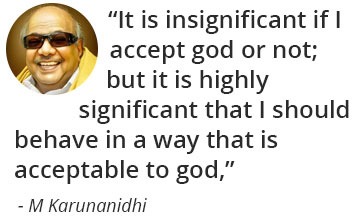பார்ப்பனீயத்தாலும் சைவத்தாலும் அழிக்கப்பட்டுத் தமிழ் மண்ணிலிருந்து துடைக்கப்பட்ட பவுத்தத்தைப் புத்துயிர்க்கும் நோக்கில் சென்ற 150 ஆண்டு காலத்தில் சென்னையை மையமாகக் கொண்டுப் பலரும் பங்காற்றியுள்ளனர். குறிப்பிட்டுச் சொல்ல வேண்டும் எனில் கர்னல் ஆல்காட், மேடம் ப்ளாவட்ஸ்கி, அயோத்திதாசர், அநகாரிக தர்மபாலா, பேராசிரியர் லட்சுமி நரசு, தந்தை பெரியார், அறிஞர் சிங்காரவேலர் முதலானோரைக் குறிப்பிட்டுச் செல்லலாம். உ.வே.சா அவர்கள் விரிந்த முன்னுரையுடன் பதிப்பித்த மணிமேகலை, கோபாலய்யரின் உரையுடன் வெளிவந்த வீர சோழியம், மயிலை சீனி வேங்கடசாமி, பேரா.சோ.ந.கந்தசாமி முதலானோரின் பதிப்பு முயற்சிகள் மற்றும் நூலாக்கங்கள் ஆகியன இன்னொரு பக்கம் பவுத்த ஆய்வுகளுக்கு முன்னோடியாக அமைந்தன.
எனினும் பவுத்தப் புத்துயிர்ப்பு இயக்கம் கடந்த 50 ஆண்டுகளில் சற்றே தொய்வுற்று இருந்தது என்றே சொல்ல வேண்டும். எழும்பூர் கென்னத் லேனில் அமைந்துள்ள புத்த மையம் இலங்கை சிங்கள பவுத்தர்களின் கட்டுப்பாட்டில் இயங்குவது. மற்றபடி தமிழகத்தில் பெரிய அளவில் வவுத்த வழிகாட்டுத் தலங்கள், ஒரு மதத்தின் இருப்பிற்குத் தேவையான சமூக ஒன்று கூடல் மையங்கள் இங்கு போதிய அளவில் கிடையாது. இல்லை எனவே சொல்லலாம். இத்தனைக்கும் எத்தனையோ புத்த சிலைகள் ஆங்காங்கு மண்ணுக்கடியில் புதையுண்டு கிடந்து கண்டு பிடிக்கப்படுவது அவ்வப்போது நடந்துகொண்டுதான் இருக்கின்றன. இடைக்காலத்தில் அயோத்திதாசரின் மகன், அன்பு பொன்னோவியம், தங்கவயல் வாணிதாசன், பெரியவர் சுந்தரராஜன் ஆகியோர் தம்மப் பணியைத் தொடர்ந்தாலும் வீச்சுடன் செயல்பாடுகள் இல்லை.
இந்நிலையில்தான் சில ஆண்டுகளுக்கு முன் ‘எங்கிருந்தோ வந்தான்….. இங்கிவனை யான் பெறவே என்ன தவம் செய்து விட்டேன்..’ என்பதைப்போல இங்கு வந்துதித்தார் பெரியவர் ஓ.ரா.ந.கிருஷ்ணன் அவர்கள். அவர் பூர்வாசிரமம் அறியேன். எப்போதாவது அறிய முனைந்தபோது மிகச் சுருக்கமான பதிலே கிடைத்தது.
அடுத்த சில ஆண்டுகளில் சென்னையை மையமாகக் கொண்டு தம்மப் பணி மீண்டும் துளிர்த்தது. பவுத்தத்தில் ஆர்வமுடையவர்களைத் தேடித் தேடிச் சென்று அவர்களை ஒருங்கிணைத்தார் பெரியவர் கிருஷ்ணன். நந்தனம் அரசு கல்லூரிப் பேராசிரியர் முனைவர் ஜெயபாலன், எங்களோடு சுயமரியாதை இயக்கத்தில் பணி செய்த என் அன்பிற்குரிய நடராஜன், தங்கவயல் வாணிதாசன் …. என இன்னும் பல பவுத்த ஆர்வலர்கள் அவரால் ஒன்றிணைக்கப்பட்டனர்.
‘போதிமுரசு’ என்றொரு காலாண்டு இதழும் உருவானது. ‘மெத்தா’ பதிப்பகம் தம்ம நூல்களை வெளியிட என உருவாக்கப்பட்டது. ‘தமிழ்நாடு பவுத்த சங்கம்’ அமைக்கப்பட்டு அதில் செயலாளராகப் பொறுப்பேற்று செயல்படத் தொடங்கினார் கிருஷ்ணன். சங்கத்தின் தலைவர் வணக்கத்துக்குரிய பிக்கு போதிபாலர்.
அப்படித்தான் ஒருநாள் என்னையும் தேடிவந்தார் பெரியவர் கிருஷ்ணன். நான் பேறு பெற்றேன். எனது ‘புத்தம் சரணம்’ நூலை மெத்தா பதிப்பகத்தில் வெளியிட வேண்டும் என்றார். பணிந்து ஏற்றுக் கொண்டேன். “ஒரு சிறந்த தம்மப் பணியாகக் கருதி இந்நூலை வெளீயிடுகிறோம்” என முன்னுரைத்து அந்நூல் அவர்களாலும் வெளியிடப்பட்டது.
கிருஷ்ணன் அவர்கள் சென்னைப் பல்கலைக் கழகங்கத்துடன் ஒருங்கிணைந்து பவுத்தவியல் கருத்தரங்குகளையும் அவ்வப்போது நடத்தி வருகிறார். அவற்றில் நானும் மறக்காமல் அழைக்கப்படுவதுண்டு.
மெத்தா பதிப்பகம் Life and Consciousness உட்பட 8 ஆங்கில நூல்கள் (இவற்றில் சில முக்கிய ஆங்கிலப் பதிப்பகங்களுடன் இணைந்து வெளியிடப் பட்டவை), நாகார்ஜுனரின் ‘சுரில்லேகா’ உட்பட 30 தமிழ் நூல்கள், லட்சுமி நரசுவின் ‘பௌத்தம் என்றால் என்ன?’ உட்பட 10 மொழியாக நூல்கள், ‘தீபவம்சம்’ உட்பட பிக்கு போதிபாலரின் 6 நூல்கள் ஆகியவற்றை வெளியிட்டுள்ளது.
ஏதாவது முக்கிய பவுத்த நூல் என அடையாளம் காட்டினால் அவற்றை உடன் ஆர்வத்துடன் வெளியிடுகின்றனர். சுமார் ஐம்பது ஆண்டுகளுக்கு முன் வெளியிடப்பட்டு இப்போது அச்சில் இல்லாத நூலொன்று என் சேகரத்தில் இருந்தது. முன்னாள் பர்மிய பிரதமர் ஊநு வின் ‘புத்தர் பிரான்’ எனும் அந்நூல் ஊநு அவர்கள் வங்கப் பல்கலைக் கழகம் ஒன்றில் ஆற்றிய உரை. நான்கு மொழிகளில் அது மொழிபெயர்த்து வெளியிடப்பட்டது. அதில் தமிழும் ஒன்று. அந்நூலை நான் நகலெடுத்து அனுப்பி அவரது கவனத்திற்குக் கொண்டுவந்தபோது அடுத்த சில வாராங்களில் அதுவும் மெத்தா வெளியீடாகப் புதிய நூலாகியது.
# # #
இருளில் ஒளியும் செஞ்சுடர், ஜே.கே – ஒரு பௌத்தரின் நோக்கில், பௌத்த வாழ்வியல் சடங்குகள், நாகார்ஜுனரின் சுரில்லேகா, திபேத்திய மரணநூல், லட்சுமி நரசுவின் பவுத்தம் என்றால் என்ன?, தலாய்லாமாவின் சொற்பொழிவுகள், தாமரை மலர்ச் சூத்திரம், பௌத்தத்தின் பார்வையில் இந்திய ஞான மரபுகள் முதலான நூல்கள் மற்றும் மொழியாக்கங்கள் பெரியவர் கிருஷ்ணன் அவர்களால் ஆக்கப்பட்டவை. (இது முழுமையான பட்டியல் அல்ல).
கிருஷ்ணனின் சில நூல்கள் ‘காலச்சுவடு’ வெளியீடாகவும் வந்துள்ளன.
கிருஷ்ணன் அவர்கள் சமீபத்தில் எழுதியுள்ள ‘இந்துத்துவமா அல்லது தம்மத்துவமா’ எனும் நூல் ஆர்.எஸ்.எஸ்சின் எடுபிடிகளில் ஒருவரான ம. வெங்கடேசன் எனும் நபர் எழுதியுள்ள ‘இந்துத்துவ அம்பேத்கர்’ எனும் ஒரு அபத்த நூலுக்கு எழுதப்பட்ட உடனடியான மறுப்புரை. “பிறக்கும்போது இந்து மதத்தில் பிறந்தேன், சாகும்போது அதில் சாக மாட்டேன்’ எனச் சொல்லி பவுத்தம் தழுவியவரும், ‘சாதிக்கோட்டையில் பிளவை ஏற்படுத்த வேண்டுமானால் பகுத்தறிவுக்கும் ஒழுக்கத்துக்கும் சிறிதும் இடம் கொடாத வேத சாத்திரங்களுக்கு வெடிவைத்தே ஆக வேண்டும்’ எனவும், ‘(இந்து மதப்) புனிதநூல்கள், புராண சாத்திரங்கள் புனிதமானவையோ. அதிகாரபூர்வமானவையோ அல்ல எனச் சட்டபூர்வமாகச் செய்ய வேண்டும்’ எனவும் ‘பார்ப்பனீயத்தையும் முதலாளியத்தையும்’ இரு பெரும் எதிரிகள் என அடையாளம் காட்டியவருமான அண்ணல் அம்பேத்கரை இந்துத்துவவாதியாகச் சித்திரித்து எழுதுவது அம்பேத்கர் அவர்களுக்கு இழைக்கப்படும் மிகப் பெரிய அவமானம். இதற்கு எதிராக எந்த எதிர்ப்பும் வராத நிலையில் அந்தப் பணியைத் தன் மேற் போட்டுக் கொண்டு கிருஷ்ணன் அவர்கள் உடன் எழுதிய அற்புதமான நூல்தான் இது.
# # #
பவுத்தத்தின் மீதும் அம்பேத்கரின் மீதும் ஒரு சேர பற்றும் மதிப்பும் உள்ள ஒருவரின் மனம் இந்த அவதூறால் எத்தனை நொந்து போகும் என்பதற்கு ஒரு வாழும் சாட்சியாக உள்ள அறிஞர் கிருஷ்ணன் அவர்களின் இந்நூலை நேற்று வெளியிட்டுப் பேசும் பொறுப்பு எனக்கு அளிக்கப்பட்டது. சற்றே உணர்ச்சிவயப்பட்டுத்தான் என்னால் அங்கு அந்த உரையை நிகழ்த்த முடிந்தது.
மறைந்த பௌத்த பிக்கு வண,போதிபாலா அவர்கள் மதுரையிலிருந்து 16 கிமீ தொலைவில் உள்ள மலையடிவாரக் கிராமமான குட்லாம்பட்டி எனும் பகுதியில் உருவாக்கியுள்ள ஒரு பௌத்த வணக்கத் தலம்தான் ‘தம்ம விஜய மகா விகாரை’. அமைதி தவழும் அந்த மலை அடிவாரத்தில்தான் நேற்று அந்த நிகழ்வு நடை பெற்றது.
நேற்றைய நிகழ்வுக்கு இலங்கையிலிருந்து பன்மொழி அறிஞரும் சிங்களத்தில் மட்டுமின்றித் தமிழிலும்30க்கும் மேற்பட்ட நூல்களை எழுதியுள்ளவருமான விஜயரத்னே, இலங்கையிலிருந்து வந்து மதுரை காமராசர் பல்கலைக் கழகத்தில் தமிழ் பயின்று வரும் வண.பிக்கு மங்கல தேரர், காந்தியியல் அறிஞர் செயப்பிரகாசம், பாலி மொழியிலிருந்து பௌத்த நூல்களை மொழியாக்கம் செய்யும் பேரா. செயப்பிரகாசம், மணிமேகலை ஆய்வாளர் பேரா. அரங்கமல்லிகா, தங்கவயல் வாணிதாசன், பவுத்த ஆய்வாளர் பேரா. ஜெயபாலன் முதலான பலரும் வந்திருந்தனர்.
காலை 11 மணி அளவில் அங்கிருந்த பவுத்த ஆலயத்தில் முறைப்படி பவுத்த வழிபாட்டை வண. போதிபாலர் தொடங்கி வைத்தார். பவுத்தம் தழுவியோர் ஆலய வளாகத்தில் விரிக்கப்பட்டிருந்த கம்பளத்திலும் எங்களைப் போன்றோர் வெளியே பந்தலில் போடப்பட்டிருந்த நாற்காலி்களிலும் அமர்ந்திருந்தோம்.
மதிய உணவுக்குப் பின் சுமார் 2.30 மணி அளவில் வண.போதிபாலர் தலைமையில் நிகழ்ச்சி தொடங்கியது. முதலில் நூல் வெளீயீடுகள். பின் உரையாற்றுவோருக்கு ஒளிபெற்றவரின் திரு உருக்கள் வழங்கப்பட்டன. பின் சர்வ சமய வழிபாடு நடைபெற்றது. இந்து, முஸ்லிம், கிறிஸ்தவ. பவுத்த மதங்களின் தோத்திரப் பாடல்களும் புனித வசனங்களும் தமிழில் வாசிக்கப்பட்டன.பின் அனைவரும் சுருக்கமாக உரையாற்றினர்.
இறுதியில் முத்தாய்ப்பாக அமைந்தது பெரியவர் ஓ.ரா.ந கிருஷ்ணன் அவர்களின் உரை.
“இந்து மதத்தின் மீது எனக்கு வெறுப்பு ஏதும் இல்லை. இந்துத்துவமா அல்லது தம்மத்துவமா எனும் மறுப்பு நூலில் நான் இரண்டுக்கும் உள்ள வேறுபாடுகளைத்தான் சொல்லியுள்ளேனே தவிர இந்து மதத்தின் மீது எங்கும் வசையாக எதையும் சொல்லிவிடவில்லை. பவுத்தத்தில் துவேஷம் / வெறுப்புக்கு இடமில்லை. அன்பு, கருணை என்பது தவிர பவுத்தத்தில் வேறெதற்கும் இடமில்லை. ஒன்றே ஒன்றை மட்டும் சொல்லி முடிக்கிறேன். என் அன்பிற்குரிய நண்பர்கள், அம்பேத்கர் பற்றாளர்கள் காந்தி மீது காட்டும் பகை மற்றும் வெறுப்பு எனக்குக் கவலை அளிக்கிறது.
உண்ணாவிரதத்தின் மூலம் காந்தி அம்பேத்கரின் கோரிக்கையை செயல்படுத்த விடாமல் செய்தது (கிட்டத் தட்ட) நூறு ஆண்டுகள் முன்பு நடந்த சம்பவம். அவர் இந்து மதத்தைத் திருத்திவிட முடியும் என நம்பினார். அது பொய்த்துவிட்டது. யாருடைய நம்பிக்கைதான் முற்றிலும் நிறைவேறி விட்டது? இந்தப் பகை தேவையற்றது. நமக்கு இன்று அண்ணல் அம்பேத்கரும் வேண்டும். கார்ல் மார்க்சும் வேண்டும். காந்தியும் வேண்டும். தயவு செய்து இதை எல்லோரும் சிந்திக்கப் பணிந்து வேண்டுகிறேன்..”
பேசும்போது பெரியவர் கிருஷ்ணன் அவர்கள் பெரியாரின் பெயரைச் சொல்லாவிடாலும் நாம் தந்தை பெரியாரையும் இதில் சேர்த்துக் கொள்ள வேண்டும். இப்படியான ஒரு பகைக்கு எதிரான குரல்கள் கடந்த சில ஆண்டுகளில் நாளுக்கு நாள் பெருகி வருவதை உணர்கிறேன். சமூக ஊடகங்களிலும் இந்தக் குரல்கள் அதிகம் ஒலிக்கத் தொடங்கி விட்டன.
பவுத்தத்தில் வெறுப்புக்கோ பகைக்கோ இடமில்லை.
கூட்டம் முடிந்த பின் பெரியவர் கிருஷ்ணனின் கைகளைப் பற்றிக் கொண்டு ,”இன்று உங்கள் பேச்சு மனசைத் தொட்டது சார். நீங்கள் சொன்னது மிக முக்கியமான செய்தி..” எனச் சொன்னபோது என் கண்கள் நீரை உகுத்தன. கடைசிச் சொற்கள் தொண்டைக்குள்ளேயே அடங்கின. அருகில் நின்றிருந்த நண்பர் பல்னீசின் கண்களும் கலங்கிச் சிவந்திருந்தன.


 Dravidian politics is not anti-god and anti-religion.
Dravidian politics is not anti-god and anti-religion.

 “It is in the smile of the poor, we see God” is another oft-repeated rhetoric of Annadurai. These words resonate deeply with people across the religious spectrum. The non-Brahmin movement’s engagement with the British created enough discourse in Tamil society about the use of ‘scriptures’ and ‘god’ to subjugate the ‘shudras’. For instance, the Dravidian political movement used the Ramayana to reconstruct a political identity in opposition to North Indian cultural hegemony. Ravana is portrayed as the symbol of the ‘oppressed’ Dravidians. Annadurai used the prevailing context to reclaim religion” and captured public imagination.
“It is in the smile of the poor, we see God” is another oft-repeated rhetoric of Annadurai. These words resonate deeply with people across the religious spectrum. The non-Brahmin movement’s engagement with the British created enough discourse in Tamil society about the use of ‘scriptures’ and ‘god’ to subjugate the ‘shudras’. For instance, the Dravidian political movement used the Ramayana to reconstruct a political identity in opposition to North Indian cultural hegemony. Ravana is portrayed as the symbol of the ‘oppressed’ Dravidians. Annadurai used the prevailing context to reclaim religion” and captured public imagination. Interestingly, Periyar EV Ramasamy (commonly known as Periyar), the rationalist founder of Dravidar Kazhagam (DK), too expressed his gratitude to god in the editorial of the first edition of ‘Kudiyarasu’ (Republic) magazine in 1925. “The rituals and caste are intricately tied to the tree of religion and god. I am trying to segregate caste from the tree of religion. When I am unable to do so, I am forced to oppose them altogether. Despite the opposition, if religion has some substance to withstand, it would continue to flourish,” is what Periyar had to say about his opposition to religion and god. He used to say to believers (in god) that his communication strategy of opposing god is to attract enough attention to the fact that inequality is perpetuated by the status quoists in the name of caste, religion and god.
Interestingly, Periyar EV Ramasamy (commonly known as Periyar), the rationalist founder of Dravidar Kazhagam (DK), too expressed his gratitude to god in the editorial of the first edition of ‘Kudiyarasu’ (Republic) magazine in 1925. “The rituals and caste are intricately tied to the tree of religion and god. I am trying to segregate caste from the tree of religion. When I am unable to do so, I am forced to oppose them altogether. Despite the opposition, if religion has some substance to withstand, it would continue to flourish,” is what Periyar had to say about his opposition to religion and god. He used to say to believers (in god) that his communication strategy of opposing god is to attract enough attention to the fact that inequality is perpetuated by the status quoists in the name of caste, religion and god.

 An RSS gathering (representational image) | Facebook
An RSS gathering (representational image) | Facebook
 This excerpt from Hindutva and Dalits: Perspectives for Understanding Communal Praxis, edited by Anand Teltumbde, has been published with permission from Sage Publications.
This excerpt from Hindutva and Dalits: Perspectives for Understanding Communal Praxis, edited by Anand Teltumbde, has been published with permission from Sage Publications.


